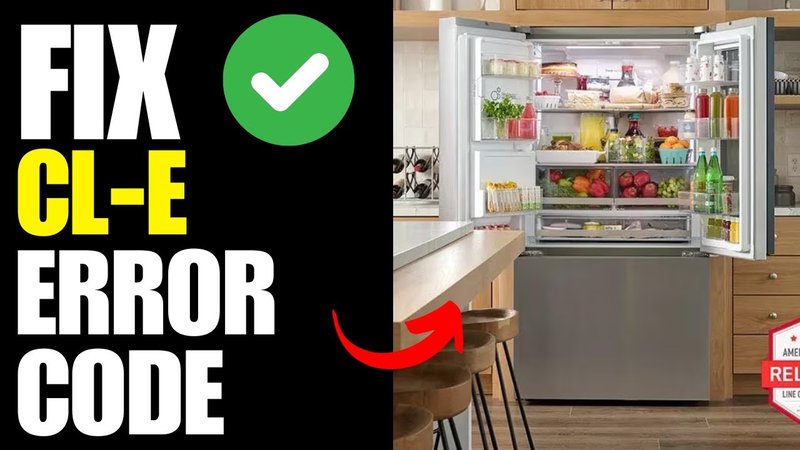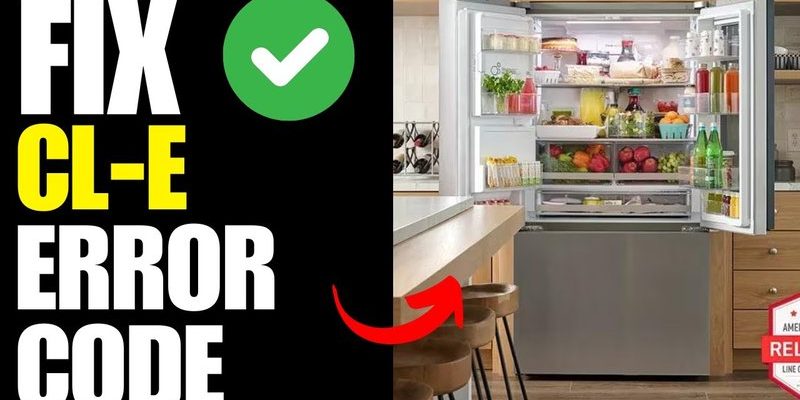
Simply put, the E3 error code typically refers to a problem with the DEF (Defrost) system. It means that your refrigerator is having trouble maintaining the right temperature due to a defrosting malfunction. This error might pop up because of something as benign as a sensor glitch or a more serious malfunction that requires professional repair. But how do you know when it’s time to roll up your sleeves for a DIY fix and when to call in the pros?
Understanding the E3 Error Code
So, what exactly causes this mysterious E3 error code? When your LG refrigerator displays this code, it’s telling you that there might be an issue with the defrost cycle. Think of the defrost cycle as your refrigerator’s equivalent of a spa day; it keeps everything smooth and running efficiently. If this cycle is off, your fridge can’t cool down properly, and that’s a big no-no for your food.
The E3 error can result from several issues such as a faulty defrost heater, a problematic control board, or a malfunctioning sensor. Imagine trying to bake a cake without setting your oven to the right temperature; that’s pretty much what’s happening inside your refrigerator. You might notice ice build-up in your freezer or your fridge feeling warmer than it should be. These are telltale signs that the defrost system is on the fritz.
Now, before you panic, remember: not every E3 error is a cause for immediate alarm. Sometimes, it might just be a temporary glitch. Unplugging your refrigerator for a few minutes to reset the system can sometimes do the trick. But if the code persists, it’s a sign that professional diagnosis is needed.
When To Troubleshoot On Your Own
Alright, so you’ve seen the E3 code pop up on your refrigerator’s display. What’s next? Before you rush to the phone to call a technician, there are a few steps you can try yourself. First, ensure that the error isn’t a simple electronic glitch. Unplug your refrigerator, wait about ten minutes, and plug it back in. This gives it a chance to reset, much like restarting your computer when it’s acting up.
If the error persists, it’s time to examine the basics. Check the refrigerator and freezer doors to make sure they’re sealing properly. A faulty seal can cause temperature variations, triggering the E3 error. If it looks like there might be a problem with the seal, you can clean it and make sure it’s free of food debris.
And then there’s the question of airflow. Make sure that your refrigerator isn’t overcrowded, which can obstruct airflow and affect cooling efficiency. Remember, your refrigerator needs space to breathe and circulate air, much like we need room to stretch and move around.
When To Call A Technician
So, you’ve tried resetting and checking for obvious issues, but that pesky E3 code still won’t quit. When is it time to call in a technician? Here’s the deal: if the error code persists after your initial troubleshooting, or if your refrigerator isn’t cooling properly, it’s best to seek professional help.
Technicians have the tools and expertise to diagnose and fix deeper issues, such as a malfunctioning defrost thermostat or heater. These components are a bit like the unsung heroes of your refrigerator, working behind the scenes to keep everything just right. When they fail, a professional can efficiently replace them to get things back on track.
Attempting to fix these complex parts on your own without the right knowledge can lead to more trouble. Imagine trying to fix a car engine without knowing how it works—that’s what it can be like tackling intricate refrigerator components without guidance. Save yourself the stress and potential additional costs by calling a certified LG technician.
Preventative Tips To Avoid Future Issues
Dealing with an E3 error code might make you wonder how to prevent such issues in the future. The good news is, with a bit of regular maintenance, you can keep your refrigerator running smoothly. Clean the condenser coils every six months to prevent dust build-up that can lead to inefficient cooling.
Keeping an eye on the door seals is another helpful preventive step. They’re crucial in maintaining the internal temperature, so ensure they’re clean and creating a good seal. And, practice mindful organization within the fridge. Remember to leave enough space for air flow so every corner of your fridge gets the cooling it needs.
If you’re still concerned or if your refrigerator is older, scheduling a routine check-up with a technician once a year can help catch potential issues before they turn into problems like the E3 error. Think of it as a health check-up for your fridge; it ensures all parts are in working order and prolongs the life of your appliance.
In summary, while the E3 error may initially seem intimidating, understanding its cause can guide you in the right direction. With a balance of DIY troubleshooting and knowing when to call a technician, you can handle this issue like a pro, ensuring your LG refrigerator stays in top shape.
